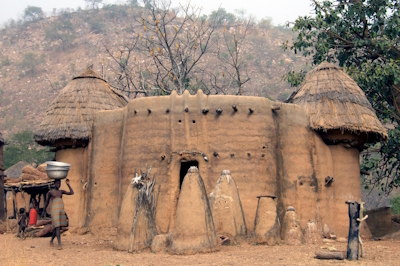Koutammakou

Koutammakou, the land of the Batammariba, is a traditional settlement known for the architecture of mud “takienta” tower houses.
Most of these buildings have two stories, and either flat or conical thatched roofs. They combine domestic functions with space for animals and granaries. Koutammakou also is a living cultural landscape where the agricultural society lives in harmony with the surrounding nature. This is expressed in sacred forests, rocks and intangible elements.
Community Perspective: a highlight of a trip to Togo, where a local guide with appropriate knowledge, contacts and language is absolutely essential.

Map of Koutammakou
Load mapCommunity Reviews
Christravelblog

Koutammakou, the land of the Batammariba, is currently the only UNESCO World Heritage Site in Togo. If you are interested in local culture and ethnicities, visiting Koutammakou should be on your Togo travel itinerary. The site can be easily reached as a day trip from Kara via Kandé, which is a 2.5-hour drive one way. This day trip was the highlight of my Togo road trip itinerary. I left Kara at around 8:30 AM and arrived at the entrance at 10:00 AM. There is a small fee that must be paid, and you must be accompanied by a local guide. It is important to respect the local Tamberma people and their traditional way of life.
Tata or Takienta houses are mud and straw castles with a ground floor for livestock, a kitchen on the "middle" floor, and sleeping quarters on the roof. With one entrance and Voodoo deities protecting it, the homes are easily defendable. The Batammariba people live in small villages grouped around a water source and fertile land, and they maintain their long-standing traditions while living in harmony with nature.
For me, this was the highlight in Togo.I really enjoyed my visit and see the locals. When I left the were just brewing their local "beer"which I had the option to taste. If you have a overreacting stomach I would refrain from trying.
It's a site quite far away and maybe on many WHS visitors "to see list". The new Togo TWHS list is also interesting. Will add these reviews as well.
Read more from Christravelblog here.
Solivagant

Anyone interested in Ethnology, Architecture, Cultural landscapes or African culture generally should try to reach this site. It consists of an area of country in NE Togo abutting Benin which is inhabited by the Battamariba people (who were called Tamberma by the colonial administration – we were told this meant “Good Builders”). Their “fortified” mud-brick houses called “Tata” (or Takienta”) are remarkable both visibly and as an introduction to their entire way of life and to their (animist) beliefs (photo). Walking the hilly savannah between the “villages”, seeing the daily life and agriculture and going inside a few houses is a fine travel experience.
The inscribed area of “Koutammakou” can be reached via a dirt road NE from Kande or by crossing from Benin near Boukombe. The area is not (yet?) on the international travel route to the same extent as Dogon country in Mali but is receiving a fair number of (mainly francophone?) tourists and visits to those Tata near to the road were somewhat more “touristy” than I had hoped, with displays of handicrafts for sale and calls for “cadeaux” from hordes of children. Across the Benin border the same people were called, pejoratively, “Somba” (= “Naked”) and, although that area is not included in the UNESCO site, it proved in our experience a more fruitful area for exploration and interaction with the Battamariba. Our (Togolese) guide claimed that there were differences in culture between Tamberma and Somba but we were never able to obtain a clear explanation of these. If our experience in Benin of walking well away from the road is valid for Togo as well then you should try to arrange such a trip. But, whatever you do, your visit will not be “impactless” (both good and bad) on these people and you will have to come to terms “morally” with this.
A local guide with appropriate knowledge, contacts and language is absolutely essential but I can give no advice on how best to choose one who will do his best to ensure as little “exploitation” as possible – guides of unknown (and no doubt variable) quality can certainly be obtained locally. We travelled with an apparently reputable Togolese travel company (TransAfrica) and felt that the visits to the houses were conducted responsibly with a reasonable recompense to the families which didn’t distort the local economy too much and with a sensitivity to the Battamariba as human beings.
Entrance to the “park” is only around 2 euro. At the entrance hut I obtained a fine 36 page colour booklet (in French) produced by CRATerre (ISBN 2-906901-39-3) with explanations of Battamariba history, religion, social organisation, farming practices and, above all the layout, construction and “meaning” of the multi-roomed houses. However good your guide might be there is just so much to take in and you will need a reference for later - but I got the last one!!
PS. This entire booklet is available for download as a PDF
Kelly Jones
I lived in this area for two years as a Peace Corps Volunteer. It is truly an amazing people and an amazing cultural experience. The architecture is phenomenal and a prideful part of their lives. There is not a lot of infrastructure develped for tourists. So visitors need to be aware of that and accomodating. Organization for toursits can also be confusing as there is currently no good set up of finding a guide, renting a car, lodging, etc. Try and make sure who you are paying is really a local person and be respectful of the community. There have been some negative effects of tourism already. Children chase cars and people beg for gifts. Don't give out gifts. But always ask before taking photographs and pay them if they ask for money or give them some other small gift.
Community Rating
Site Info
- Full Name
- Koutammakou, the Land of the Batammariba
- Unesco ID
- 1140
- Country
- Togo
- Inscribed
- 2004
- Type
- Cultural
- Criteria
-
5 6
- Categories
- Cultural Landscape - Continuing
- Link
- By ID
Site History
2004 Inscribed
Site Links
Unesco Website
Official Website
Related
Connections
The site has 19 connections
Architecture
Constructions
Geography
Human Activity
Timeline
Trivia
Visiting conditions
WHS on Other Lists
World Heritage Process
Visitors
27 Community Members have visited.